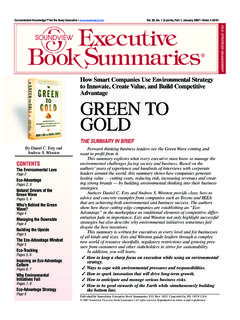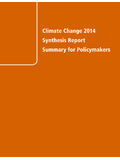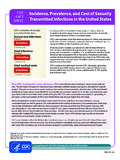Transcription of Metallgesellschaft AG and Its Hedging Program
1 Chester Lee (Wharton MBA, Class of 2011) prepared this case under the supervision of Assistant Professor Anastasia V. Kartasheva, The Wharton School, as the basis for class discussion rather than to illustrate either effective or ineffective handling of an administrative situation. Copyright 2011 The Wharton School of the University of Pennsylvania. All rights reserved. You may not copy, reproduce, create derivative works from, publicly distribute, or publicly display or transmit any of these materials, including but not limited to storage in a retrieval system, or transmission electronically, mechanically, via photocopying, recording, or other means, without prior written permission from the Wharton School, except as permitted by law.
2 To request permission, please contact Some of these materials are used with permission from third parties and are not owned by the Wharton School. Metallgesellschaft AG and Its Hedging Program Derivatives are financial weapons of mass destruction, carrying dangers that, while now latent, are potentially lethal. Berkshire Hathaway Inc. Chairman of the Board Warren Buffet, Letter to the Shareholders of Berkshire Hathaway Inc., February 21, 2003 INTRODUCTION In December 1993, Metallgesellschaft AG (MG), once Germany s 14th largest conglomerate with 258 subsidiaries subdivided into 5 branches (trade, finance, engineering and contracting, chemicals, and building technology) went nearly bankrupt after suffering US$ billion of losses from its energy derivative trading MG s subsidiary, MG Refining and Marketing Inc.
3 (MGRM), was responsible for these derivative trades that generated the What was surprising though was the fact that the losses, and the subsequent near bankruptcy, were the result of MGRM s risk management Program that was supposed to hedge the risks from its customers trades. When an entity puts on a trade which could be as simple as buying or selling a stock or as complicated as entering into a derivative trade it is exposed to various risks that could result in gains or losses when the market moves. A hedge is supposed to offset these risks. MGRM certainly had significant risks from the trades it put on with its customers, but it also had an active Hedging Program that should have offset these risks.
4 How did MGRM generate such huge losses? What went wrong? 1 Big German Concern s Loss, The New York Times, July 9, 1994; , Metallgesellschaft AG: International Directory of Company Histories, 1997; Sharon Reier, Metallgesellschaft endures despite war, debt and rumor: Easy to beat up, hard to kill, The New York Times, March 23, 2002. 2 Ibid. Metallgesellschaft AG and Its Hedging Program Case-68 THE WHARTON SCHOOL OF THE UNIVERSITY OF PENNSYLVANIA 2 COMPANY INFORMATION MG was founded in Frankfurt, Germany, in 1881. Its early business involved metal trading at the time when Western Europe was going through the Second Industrial Revolution.
5 Because Germany s domestic production was not able to keep up with demand, MG quickly turned to overseas markets to secure its metal supply. MG first started its operation when it founded the American Metal Company in New York as a subsidiary in MG s history mirrored the rise and fall of Germany s industrial history through World War I and World War II. By 1945, many of MG s businesses were in ruins, but, just as the country achieved a remarkable recovery, MG was able to recover from the wars and grow into an industrial conglomerate over the next four decades. In 1989, Heinz Schimmelbusch was appointed the chairman of the MG board.
6 A young and energetic executive with a vision, Schimmelbusch completed a series of acquisitions, dramatically increasing the size of the company and expanding into new businesses. By the early 1990s, MG had more than 50,000 employees with US$17 billion in MG s operation went through a significant reorganization in the 1980s. MG established capabilities to trade financial instruments and commodities. MGRM, a subsidiary, started a new energy business in the early 1990s that offered contracts to its customers that allowed them to buy oil products ( , gasoline and heating oil) from MGRM at a fixed price over many years.
7 MGRM s new business took off quickly, and it had accumulated a significant amount of contracts by 1993. Instead of securing physical oil and storing it for future sale, MGRM adopted a synthetic storage strategy that allowed it to secure its oil supply via futures The ability to secure oil via derivative trades was at the core of MGRM s Hedging Program . MGRM S CUSTOMER TRADES AND HEDGES For many gas station and small business owners who did not have much bargaining power against large oil companies, MGRM s contracts were attractive ways to hedge themselves against wild oil price fluctuations that could potentially hurt profitability.
8 Moreover, falling oil prices following the Gulf War offered an attractive opportunity to lock in oil prices at low levels. MGRM offered various types of contracts to its customers. The most typical contract involved MGRM selling a fixed volume of an oil product at a fixed price every month for up to 10 years. The contracts gave the buyer an option of early termination with a specified mechanism, and some contracts allowed the buyers to set the delivery 3 , loc. cit. 4 Ibid.; Reier, loc. cit. 5 Christopher L. Culp and Merton H. Miller, Metallgesellschaft and the Economics of Synthetic Storage, Journal of Applied Corporate Finance 7, no.
9 4 (Winter 1995): 66. 6 Antonio S. Mellow and John E. Parsons, Maturity Structure of Hedge Matters: Lessons from the Metallgesellschaft Debacle, Journal of Applied Corporate Finance 8, no. 1 (Spring 1995): 106. Metallgesellschaft AG and Its Hedging Program Case-68 THE WHARTON SCHOOL OF THE UNIVERSITY OF PENNSYLVANIA 3 For the analysis of this case, consider the following simplified structure: MGRM puts on a trade (the term trade is interchangeable with the term contract ) with a client where MGRM sells a fixed amount of oil products at a fixed price every month for 10 years. MGRM expects that the fixed price is higher than the prevailing oil price, thereby allowing MGRM to capture profit.
10 For example, suppose the spot price of crude oil is US$17 per barrel. A customer who wants to reduce his exposure to oil price risk can put on a trade with MGRM to buy 1,000 barrels of oil every month at US$20 per barrel for 10 years. The amount of oil that MGRM commits to deliver to the customer over the life of the contract is 120,000 barrels (1,000 barrels per month x 12 months per year x 10 years). By 1993, MGRM had put on trades to sell more than 150 million barrels of oil products to its customers over the next 10 Since MGRM did not have oil in its inventory, the customer trades exposed MGRM to huge market risks.








